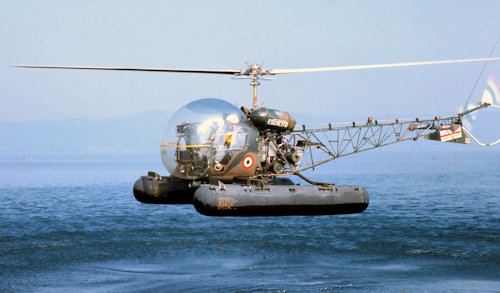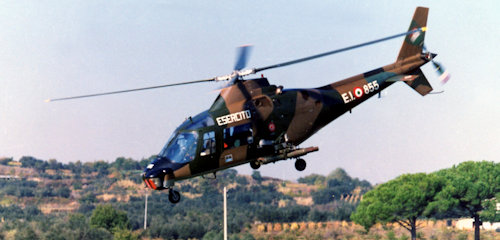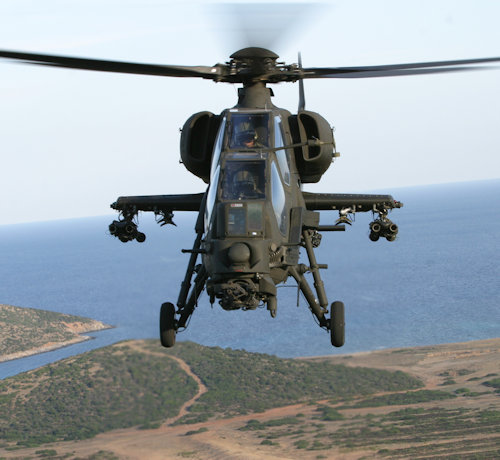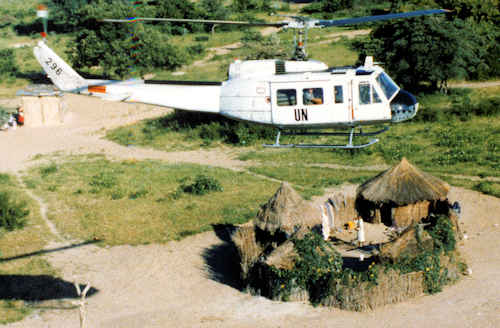AVES is the youngest of the Army specialties, born only 66 years, celebrated the 10 last May (v.articolo), but this does not make it the least important, indeed. Because in its 66 years of history, Army Aviation has always been called into question wherever it is needed. But let's rethink its history from birth to today.
It was the 1950, a year before the very constitution of a first Army Warfare, when, thanks to US military aid after the ratification of the Treaty of Peace and the birth of NATO, the Army General Staff sent 15 officers of various Army weapons in the United States, in order to achieve the pilot patent. Those who passed the course, obtaining the patent, became the barefoot of the flying wards, with the task, basically to say the least, to train future pilots. But it was not just the achievement of the pilot patent, because the Piper L-18 and the most powerful L-21A and L-21B came from the United States. They were the first airplanes supplied to the Army since, in the 1923, the Aeronautical Regia was born, a rib distaccata dal Aeronautical Service of the Royal Army.
The first flight department will be founded the following year, precisely on May 10, 1951, at Monte dell'Oro, near Bracciano (RM), thanks also in this case to the invaluable US contribution that made it possible to quickly build the runway. landing on grass. The choice to establish it in Bracciano was not accidental, because in the medieval village on the lake of the same name the artillery school had (and still has, ed) headquarters, which employed the newborn "Light Aircraft Department", which soon changed the name in "Air Artillery Department". Not even a year passes and in 1952 the Monte dell'Oro airfield becomes fully operational, becoming the seat of the 1st course for observer pilots, with the civil license divided into two degrees: the first to be able to fly solo ; the second to be able to carry a passenger, with tasks as an observer or as a specialist.
 The 1953 was a very important year for this newly born specialty, because in order to cope with the training efforts that were created, the "Aeronautical Observation Training Center for Artillery" was founded (CAOAA), which would have served to train, in addition to the pilots, even the specialists, who came from all the weapons of the Army. On the Bracciano flight field, therefore, the logistic needs of personnel management, the means and the maintenance itself could be increased and, for this reason, the 1 ° was established. Light Aeration Repair Department (RRALE), in order to satisfy all maintenance and repair issues that can be carried out on site.
The 1953 was a very important year for this newly born specialty, because in order to cope with the training efforts that were created, the "Aeronautical Observation Training Center for Artillery" was founded (CAOAA), which would have served to train, in addition to the pilots, even the specialists, who came from all the weapons of the Army. On the Bracciano flight field, therefore, the logistic needs of personnel management, the means and the maintenance itself could be increased and, for this reason, the 1 ° was established. Light Aeration Repair Department (RRALE), in order to satisfy all maintenance and repair issues that can be carried out on site.
The first commander of the CAOAA, the ten. with the. Francesco Muscarà, did everything to make the flight department a professional component indispensable for all the land forces. Thought that had developed during the war, where he had seen how the Americans used light aircraft to help artillery shots.
The Army Air Force Building continued and after the 1 ° RRALE was formed, the "Light Air Section" was also created with Piper CA-18 (L-21), which was assigned to all body commands armies, divisions, brigades and cavalry regiments, armored infantry and artillery. Muscarà's project became reality.
1956, however, saw the birth of the experimental helicopter department, to which the first 4 Agusta Bell 47-G2s were assigned Sioux and the first Agusta Bell 47-J Cleaning, thus sanctioning the arrival of helicopters in the Army. The component that over the years has become the sign of recognition for Army Aviation. But the experimental department had a short life, so that in September of the 1958 the first two units with only helicopters were born, namely the 1 ° helicopter department of Casarsa della Delizia and the 2 ° department of Bolzano, who went to support at the Training Center of Bracciano.

Within two years, the very specialty began to develop rapidly and relentlessly, also undergoing the first transfer: because the CAOAA was transformed into the "Light Air Force Training Center" (CAALE) and moved from the Savini airport of Bracciano to the airport of Viterbo. In addition to moving home, the specialty also changed its membership because it was released from the Artillery School's dependence and moved to the dependencies of the AI Inspectorate, established in January of the 1959; thus marking the start of what became the Army Aviation Command today.
The birth, however, of rotating wings in the north of Italy "forced" the Major State to establish another repair department in Bologna, allowing to shorten the logistic arm with the newly-formed departments of Casarsa and Bolzano.
After years of 50, years that saw the birth of the Army's aeronautical component and its growth, with the formation of 2 rotating wing units and the transfer of the Training Center to Viterbo with the following birth of the " ALE Inspectorate, the 60 years were decisive for the consolidation and development of Army Aviation.

The old Piper L-21 came alongside the Cessna L-19 E Bird Dog, completely made of metal and equipped with a more complete instrumentation, and at the same time, civilian brigades, with the army's fixed wing aircraft, were removed, paving the way for the progressive numbering preceded by the letter EI. Thus, the Army, as well as aircraft more modern, even with their own airplane serial number.
As for the rotating wing component, the first five years of the 60 years was crucial for the arrival of the first true helicopters utility, the AB-204 followed by the AB-205, the two helicopters that will become the backbone of the Army's rotating wing component, remaining in service for many years and in the case of the still-serving AB-205, pending the arrival of a new helicopter that will replace it.
Meanwhile, however, due to the arrival of the new media and the numbering of specialists, the first organic transformation of the Light Air Force was also carried out. The Air Force departments remained in the armed forces, divisions and brigades, with transport and air reconnaissance tasks, as well as the helicopter wards general use, framed at the armed body level and the Army's senior staff. The helicopter sections of general use, with the AB 205, were placed in the parachute brigade, the missile brigade and the military command of Sardinia.

It was a real refurbishment that provided the Army Lightweight Airship, however, a more organic and widespread structure in the area, obviously of the increasing number of pilots and specialists.
In 1967, then, in a decade to say the least fundamental to the ALE, new AB 206 reconnaissance helicopters were made available, increasing the number of aircraft in the fleet. This increase in resources, to which the specialty renovation was to be added, meant that the training of the staff began to take place more logically: the pool of specialists and pilots was found both in staff already qualified on light aircraft and by recruiting from other Army Specialties or directly from School Marescialli Students of Viterbo. Furthermore, those who would have wanted to become pilots of helicopters or light aircraft, before arriving at the training at the CAALE in Viterbo had to attend and, of course, pass the basic qualification course at the flight school of the 72 ° Stormo di Frosinone. This also led to the birth of a new RRALE department, the 3rd, located at Bergamo's Orio al Serio airport.

If we consider the 60 years as the decisive decades for Army Aviation we know today, even the 70 years were no less: before, in 1971, came the Basco Azzurro, the new headgear for specialty, then in 1973, Viterbo arrived the first CH-47C "Chinook", transport helicopters that had already demonstrated reliability and operational capabilities during the Vietnam War, where the United States used massively this two-rotor "giant".
In the 1975, the first major transformation of the Army was also implemented, the "great reform" changed the structure of the earth's forces, and also changed the ALE, which was directed not so much on quantity but as on quality: media, pilots, specialists and operational strategies. Another change was that of departmental names, which took the name of a star, in the case of groupings, and of a constellation or a planet, for squad groups.
Army Reform did not stop the rise and modernization of the AAL, which in 1976 saw the delivery of the first A-109, which will become the base for the launch of counter rockets that will be used in the development of the A- 129, the first Italian fighter helicopter.

This great development allowed the Army's Aviation to be known and appreciated, also, in the international arena. The occasion was presented at the 1979 when Italy participated massively at the UNIFIL mission (United Nations Interim Force in Lebanon - United Nations Lebanese Interposition Force), where the Army helicopters were deployed at the base of Naqoura, located in southern Lebanon. It was the first international military mission since the Second World War, for Italy and for the ALE, who acted and behaves still, impeccably, doing all the tasks best suited.
But the missions were not, and are not yet, only international ones, because Army Aviation, since flooding caused by the collapse of the Vajont dam (1963) onwards, is used massively, even in virtue of its importance, in the natural calamities that affect our country. The importance of the work of the "blue basks" on these occasions is well demonstrated by the praise of the affected populations and innumerable decorations to the flags of the various AVES departments, even if it is enough to look at the last earthquake that struck Italy to understand the importance of helicopters on these occasions, as they allow for fast rescue operations and transportation of food, vehicles and heavy goods.
 Returning to the evolution of AVES, if the twenties of the 60 and 70 years were the years of development and consolidation of Army Aviation, the 80 years were the classic moment of passage. Noteworthy were two events: the start-up of AB-212 and the radiation of AB-204. At the same time, however, the modernization of the media continued with the first experimental flight of the A129 "Mangusta": a long project that is rooted in the late 70. The Mangusta entered into actual service at the beginning of the 90 years and had its baptism of fire in the "tragic" battle of Checkpoint Pasta, when the crew struck an anti-tank missile with an Italian VM-90 that had been captured by Somali rebels. The world had changed, the Cold War was over and a new world full of challenges opened up, therefore, in the face of the future of our state and, consequently, of our armed forces: international missions under UN aegis became increasingly dangerous and, where necessary, armed intervention was paramount. This was what emerged from the Battle of Checkpoint Pasta (where 3 was eventually killed and 36 wounded for the Italian Army).
Returning to the evolution of AVES, if the twenties of the 60 and 70 years were the years of development and consolidation of Army Aviation, the 80 years were the classic moment of passage. Noteworthy were two events: the start-up of AB-212 and the radiation of AB-204. At the same time, however, the modernization of the media continued with the first experimental flight of the A129 "Mangusta": a long project that is rooted in the late 70. The Mangusta entered into actual service at the beginning of the 90 years and had its baptism of fire in the "tragic" battle of Checkpoint Pasta, when the crew struck an anti-tank missile with an Italian VM-90 that had been captured by Somali rebels. The world had changed, the Cold War was over and a new world full of challenges opened up, therefore, in the face of the future of our state and, consequently, of our armed forces: international missions under UN aegis became increasingly dangerous and, where necessary, armed intervention was paramount. This was what emerged from the Battle of Checkpoint Pasta (where 3 was eventually killed and 36 wounded for the Italian Army).
Meanwhile, the 12 June 1993, the ALE changed name by becoming AVES, that is, the current Aviation Aircraft denomination, while removing weight restrictions on fixed-wing vehicles. Name that was changed for a short time to "Cavalry of the Air" and then quickly returned to 2003 to be known as Army Aviation, a name that was bound indissolubly inside and outside of the specialty.
 From the turning point of the Battle of Checkpoint Pasta, AVES continued to be used in all international operations, performing the tasks assigned in a perfect way and allowing constant support for troops engaged in land operations.
From the turning point of the Battle of Checkpoint Pasta, AVES continued to be used in all international operations, performing the tasks assigned in a perfect way and allowing constant support for troops engaged in land operations.
In the meantime, however, it continued to update its means and to buy and develop new ones, such as the j European project for the realization of the NH-90, the helicopter that will be the future backbone of the AVES that is emerging in this Third Millennium: with the look always facing the future, but without denying and forgetting its past.
We will talk about this future with the Army Aviation Commander, Brigadier General Paolo Riccò, in the second and last stage of the "voyage" in the AVES.
(photo: AVES)












